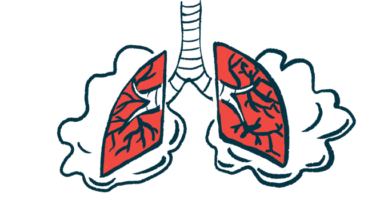Antioxidant alpha-lipoic acid may help reduce lung damage in PF
Naturally occurring ALA protects cells against toxic effects of iron overload

The naturally occurring antioxidant alpha-lipoic acid, or ALA, which protects cells against the toxic effects of iron overload, may help reduce lung damage caused by silica — dust particles often found at construction sites and in mining — in pulmonary fibrosis (PF).
That’s according to a study using lab-grown cells and a mouse model of silicosis, a lung disease caused by breathing in particles of silica dust. Over time, these particles can damage lung cells, leading to lung scarring, or fibrosis.
People with PF due to silicosis typically have symptoms that include shortness of breath, cough, fatigue, and weight loss.
In this study, researchers in China sought to investigate in the laboratory whether ALA can reduce the effects of silica-induced PF by regulating iron metabolism in airway cells.
Their findings were detailed in “Α-Lipoic acid attenuates silica-induced pulmonary fibrosis through maintenance of iron homeostasis and improving mitochondrial function in airway epithelial cells,” a study published in the journal International Immunopharmacology.
How exactly silica dust causes PF is unclear, but problems with iron metabolism, or how the body manages iron, have been suggested to play a role. When excessive iron builds up in the body, known as iron overload, it can be toxic and damage cells. Iron also plays a role in a form of cell death called ferroptosis.
Researchers call alpha-lipoic acid a ‘potent antioxidant’
The antioxidant ALA helps balance how much iron is stored or used in the body. It also reduces oxidative stress, which occurs when toxic molecules called free radicals are not counteracted by antioxidants.
As such, according to the researchers, treatment with ALA “may be an effective intervention strategy for silicosis.” The team noted that ALA is a “potent antioxidant.”
In the lab, the team set out to test if ALA could reduce lung damage caused by silica, starting with lab-grown bronchial epithelial cells — the type of cell that lines the airways.
As expected, adding silica to these cells caused their death. The higher the levels of silica, the fewer cells remained alive. With ALA, however, these cells not only remained alive but also grew in number, even in the presence of silica.
Unlike silica, which caused excess iron to build up in bronchial epithelial cells, ALA reduced iron to control levels. It also reduced the levels of ferritin, an iron-containing protein that stores iron in the body’s cells. In addition, silica reduced TFR1, a protein that helps bring iron into cells, whereas coadministration of ALA helped increase this protein’s levels.
Under a microscope, the researchers observed that silica caused mitochondria — the structures that produce energy — in bronchial epithelial cells to shrink and become damaged. These changes were no longer observed when ALA was added. ALA also increased the levels of ATP, considered the main energy currency of cells.
In mice, ALA helped keep iron balanced, reduced lung damage
Building on these findings, the researchers turned to a mouse model of silicosis. Wild-type (healthy) mice and mice engineered to produce high levels of lipoic acid synthase — an enzyme involved in the production of ALA — were exposed to silica, silica plus iron, or a placebo.
Lungs of wild-type mice exposed to silica were inflamed and developed silicosis nodules, or small, fibrotic lesions caused by breathing in particles of silica dust. Mice producing high levels of lipoic acid synthase developed no silicosis nodules, suggesting that ALA may reduce lung damage caused by silica. Adding iron, however, increased lung damage.
Levels of iron in the lungs increased in both wild-type and engineered mice exposed to silica, the researchers noted. However, these levels were lower in engineered mice treated with ferrostatin, an inhibitor of ferroptosis, than in wild-type mice. Adding iron reversed this effect.
Overall, the team noted, lipoic acid synthase reduced lung damage by keeping iron balanced and enhancing the antioxidant response in silicosis.
These findings led the team to conclude that ALA “is beneficial for reducing pulmonary fibrosis by inhibiting oxidative stress, thus protecting the mitochondria.” These findings suggest a new strategy to treat silica-induced pulmonary fibrosis, according to the researchers.









